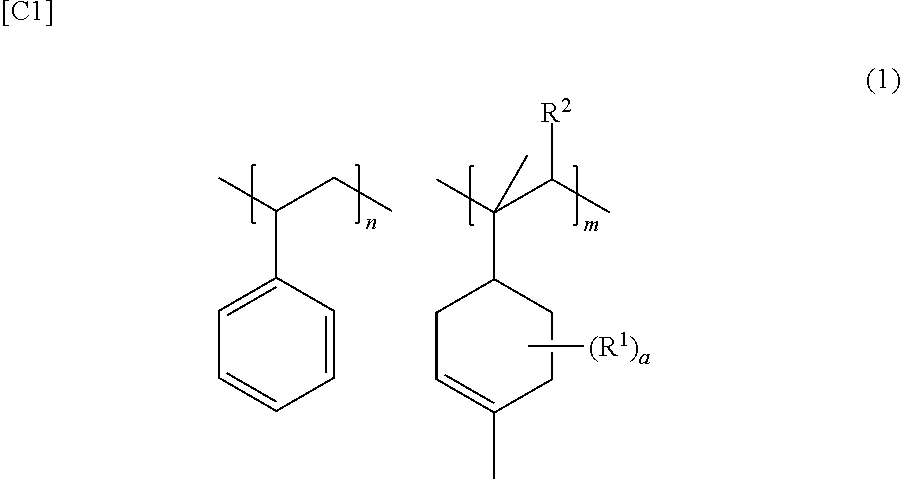Hot melt adhesive
- Summary
- Abstract
- Description
- Claims
- Application Information
AI Technical Summary
Benefits of technology
Problems solved by technology
Method used
Image
Examples
manufacturing example 1
Acid-Modified Tackifier 1
[0099]A total of 750 g of a hydrogenated aromatic modified terpene resin (CLEARON K4100, manufactured by YASUHARA CHEMICAL CO., LTD.: softening point 100° C.) was loaded into a stainless steel (SUS) reaction kettle and melted at 170° C. A nitrogen atmosphere was then created in the reaction kettle and 22.5 g of anhydrous maleic acid, 5 g of dicumyl peroxide, and 22.5 g of butyl methacrylate were dropped for 1 h into the melt in the reaction kettle. After the dropping was completed, stirring was conducted for 30 min at 170° C., and the reaction kettle was then depressurized, thereby removing, over 1 h, the unreacted matter and low-molecular compounds produced by the decomposition of dicumyl peroxide. As a result, a light-yellow solid matter was obtained. This solid matter was a hydrogenated aromatic modified terpene resin modified by anhydrous maleic acid and butyl methacrylate (acid-modified tackifier 1). The obtained acid-modified tackifier 1 had a melt vis...
manufacturing example 2
Acid-Modified Tackifier 2
[0100]An acid-modified tackifier 2 was manufactured in the same manner as in Manufacturing Example 1, except that a hydrogenated terpene resin (CLEARON P115, manufactured by YASUHARA CHEMICAL CO., LTD.: softening point 115° C.) was used instead of the hydrogenated aromatic modified terpene resin. The acid-modified tackifier 2 was a hydrogenated terpene resin modified by anhydrous maleic acid and butyl methacrylate. The obtained acid-modified tackifier 2 had a melt viscosity of 3,200 mPa·s at 140° C. and a weight-average molecular weight of 1,120.
manufacturing example 3
Acid-Modified Tackifier 3
[0101]An acid-modified tackifier 3 was manufactured in the same manner as in Manufacturing Example 1, except that a hydrogenated alicyclic petroleum resin (ARKON M-100, manufactured by Arakawa Chemical Industries, Ltd.: softening point 100° C.) was used instead of the hydrogenated aromatic modified terpene resin. The acid-modified tackifier 3 was a hydrogenated alicyclic petroleum resin modified by anhydrous maleic acid and butyl methacrylate. The obtained acid-modified tackifier 3 had a melt viscosity of 3,700 mPa·s at 140° C. and a weight-average molecular weight of 1,170.
PUM
| Property | Measurement | Unit |
|---|---|---|
| Percent by mass | aaaaa | aaaaa |
| Percent by mass | aaaaa | aaaaa |
| Percent by mass | aaaaa | aaaaa |
Abstract
Description
Claims
Application Information
 Login to View More
Login to View More - R&D
- Intellectual Property
- Life Sciences
- Materials
- Tech Scout
- Unparalleled Data Quality
- Higher Quality Content
- 60% Fewer Hallucinations
Browse by: Latest US Patents, China's latest patents, Technical Efficacy Thesaurus, Application Domain, Technology Topic, Popular Technical Reports.
© 2025 PatSnap. All rights reserved.Legal|Privacy policy|Modern Slavery Act Transparency Statement|Sitemap|About US| Contact US: help@patsnap.com


